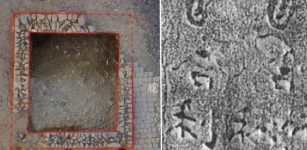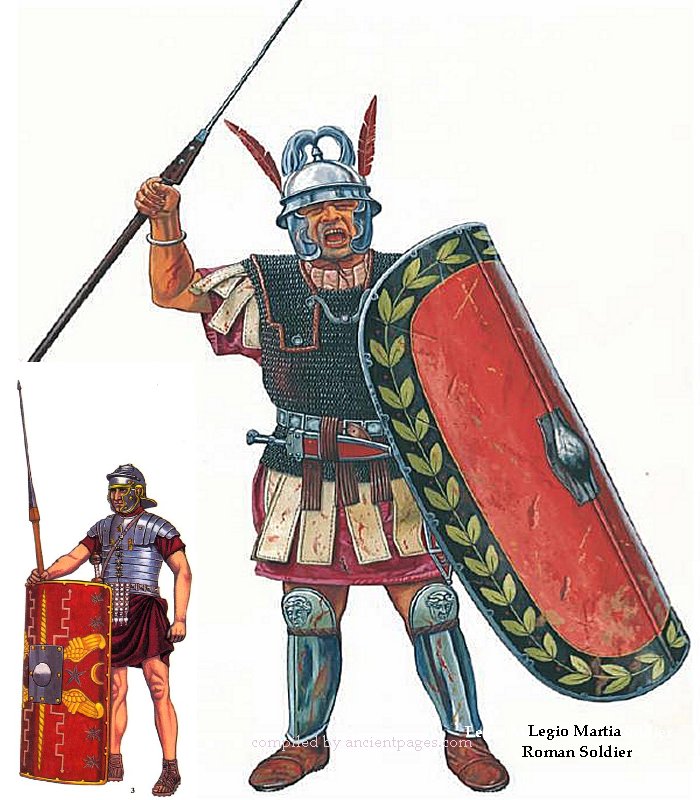What Was Legio Martia And Why Were The Roman Soldiers Called The Martians?
AncientPages.com - Legio Martia means 'Legion of Mars' (sacred to Mars) was the name of a legion of Roman infantry. The soldiers were widely respected for their extraordinary bravery, which inspired to give them the name the 'Martian legion or the Martians – ‘warlike’.
This Roman military unit was formed by Gaius Julius Caesar in 48-49 BC, as described by Appiano in his "Civil War". It was made up of about 22,000 men, divided into eight legions. It was enlisted among the Italic citizens to fight against Gneo Pompeo Magno, took part in the subsequent battle of Pharsalus, after which it obtained the honorary appellation of Martia, which is worthy of Mars, God of war.
The unit fought again for Caesar in the Battle of Tapso, then passed to Marcus Antonius first and then to Octavian later.
Other historical sources associate the Legio Martia with one of the various legions coming from the Italic area of the ancient Martia, today's Marsica from which it took its name, and the honors were attributed to it following the victories reported in the various battlefields, from Gaul to 'Africa.
Ancient records say that the legionaries who had followed Caesar in the long campaign of Gaul, whom he had been able to guide, support, defend with such intelligence and respect that men would have fought for him to the death. The veterans of the Gauls were the best you could wish for in battle, brave, faithful, trained, and effective as well as fast and diligent executors, but never rebels.
The Martians are mentioned in many ancient historical sources, such as for example, Cicero’s work known as ‘Philippics’ I.8). Cicero mentions them as an important part of Octavian's army. The Martians of Legio Martia represented one of six legions stationed in Macedonia for Caesar's planned Parthian expedition.
Appian of Alexandria (95 AD – 165 AD), a Greek historian with Roman citizenship who flourished during the reigns of such personalities as Emperors of Rome Trajan, Hadrian, and Antoninus Pius, describes the Martians and the role they played as the vanguard of Octavian's force in the civil wars.
He also describes the final fate of the Legion Martia, which took place on the same day as the Battle of Philippi (42 BC) - the final battle in the Wars of the Second Triumvirate.
The Martians were crossing the Adriatic Sea in transport vessels when they were met by 130 enemy warships.
In his 'Civil Wars', Appian says:
‘The men who were exposed to this danger performed many deeds of valor.
Sometimes they hastily warped their ships together with ropes and made them fast with spars to prevent the enemy from breaking through their line.
But when they succeeded in doing this (the enemy) discharged burning arrows at them. Then they cast off their fastenings as quickly as possible and separated from each other on account of the fire and thus again were exposed to being surrounded or rammed by the triremes…’
Some of the soldiers, and especially the Martians, who excelled in bravery, were exasperated that they should lose their lives uselessly, and so killed themselves rather than be burned to death; others leaped on board the triremes of the enemy, selling their lives dearly. (Appian, Civil Wars IV 115-116).
Copyright © AncientPages.com All rights reserved. This material may not be published, broadcast, rewritten or redistributed in whole or part without the express written permission of AncientPages.com
Expand for referencesMore From Ancient Pages
-
 First Roman Military Amphitheater Unearthed Near Megiddo
Archaeology | Jun 1, 2022
First Roman Military Amphitheater Unearthed Near Megiddo
Archaeology | Jun 1, 2022 -
 Ancient Gymnasium Discovered In Egypt
Archaeology | Nov 6, 2017
Ancient Gymnasium Discovered In Egypt
Archaeology | Nov 6, 2017 -
 Did Captain Robert Jenkins’ Ear Start A War That Lasted 9 Years?
Ancient History Facts | Jun 24, 2017
Did Captain Robert Jenkins’ Ear Start A War That Lasted 9 Years?
Ancient History Facts | Jun 24, 2017 -
 Archaic Marble Lions On The Sacred Island Of Delos
Artifacts | Feb 27, 2021
Archaic Marble Lions On The Sacred Island Of Delos
Artifacts | Feb 27, 2021 -
 Goddess Xi Wangmu (Xiwangmu) Who Controlled Life, Death, Creation And Talked Directly To Humans In Chinese Mythology
Chinese Mythology | Mar 12, 2020
Goddess Xi Wangmu (Xiwangmu) Who Controlled Life, Death, Creation And Talked Directly To Humans In Chinese Mythology
Chinese Mythology | Mar 12, 2020 -
 Inscription At Aquae Calidae Sheds Light On Last Years Of Ancient Thrace’s History
News | Aug 30, 2015
Inscription At Aquae Calidae Sheds Light On Last Years Of Ancient Thrace’s History
News | Aug 30, 2015 -
 Incredibly Rare 3,500-Year-Old Wooden Spade Found In English Trench
Artifacts | Oct 30, 2024
Incredibly Rare 3,500-Year-Old Wooden Spade Found In English Trench
Artifacts | Oct 30, 2024 -
 Ancient Temple Complex Dated To Nanzhao Kingdom Unearthed In Southwest China
Archaeology | Jan 26, 2021
Ancient Temple Complex Dated To Nanzhao Kingdom Unearthed In Southwest China
Archaeology | Jan 26, 2021 -
 Human-Driven Mass Extinction Is Eliminating Entire Branches Of The Tree Of Life – New Study
Biology | Sep 19, 2023
Human-Driven Mass Extinction Is Eliminating Entire Branches Of The Tree Of Life – New Study
Biology | Sep 19, 2023 -
 On This Day In History: Anders Celsius, Swedish Astronomer And Mathematician Was Born – On Nov 27, 1701
News | Nov 26, 2016
On This Day In History: Anders Celsius, Swedish Astronomer And Mathematician Was Born – On Nov 27, 1701
News | Nov 26, 2016 -
 Mystery Of The Giant Laos Jars Continues – New Discoveries Reported By Scientists
Archaeology | Apr 19, 2021
Mystery Of The Giant Laos Jars Continues – New Discoveries Reported By Scientists
Archaeology | Apr 19, 2021 -
 Jackalope – Are Mythical Horned Hares Real?
Featured Stories | Mar 11, 2019
Jackalope – Are Mythical Horned Hares Real?
Featured Stories | Mar 11, 2019 -
 Why Did Stone Age People Cut Off Their Fingers?
Archaeology | Dec 6, 2018
Why Did Stone Age People Cut Off Their Fingers?
Archaeology | Dec 6, 2018 -
 Mystery Of 2000-Year-Old Basel Papyrus Likely Written By Physician Galen – Is Solved
Archaeology | Jul 14, 2018
Mystery Of 2000-Year-Old Basel Papyrus Likely Written By Physician Galen – Is Solved
Archaeology | Jul 14, 2018 -
 Ancient Underwater ‘Lion City’ Rests Beneath The Thousand Island Lake
News | Feb 11, 2014
Ancient Underwater ‘Lion City’ Rests Beneath The Thousand Island Lake
News | Feb 11, 2014 -
 Colossus of Ramesess II At Karnak Temples Is Undergoing Restoration
Archaeology | Feb 24, 2017
Colossus of Ramesess II At Karnak Temples Is Undergoing Restoration
Archaeology | Feb 24, 2017 -
 Native Americans Helped Shape The Klamath’s Forests For A Millennia Before European Colonization
Archaeology | Mar 21, 2022
Native Americans Helped Shape The Klamath’s Forests For A Millennia Before European Colonization
Archaeology | Mar 21, 2022 -
 Unearthing Vadnagar And The Search For Hueng Tsang’s 10 Monasteries
Archaeology | Dec 11, 2015
Unearthing Vadnagar And The Search For Hueng Tsang’s 10 Monasteries
Archaeology | Dec 11, 2015 -
 Giant 4,500-Year-Old Axe Grinding Site Discovered In Scotland
Archaeology | Dec 13, 2022
Giant 4,500-Year-Old Axe Grinding Site Discovered In Scotland
Archaeology | Dec 13, 2022 -
 Ancient Cranial Modification In Peru Led To Social Inequality
Archaeology | Jan 24, 2018
Ancient Cranial Modification In Peru Led To Social Inequality
Archaeology | Jan 24, 2018

